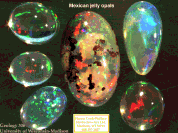AGATE AND OPALS


There are three general opal groups:
Precious opal, which displays 'opalescence' (spectral color, irridescence that c
hanges with the angle at which the gem is viewed).
Two subgroups:
Examples:
Fire opal is transparent or translucent with an
orange or red body color. Fire opals are named for their color (but are not
opalescent). The term is often misinterpreted to indicate that
fire opal is opalescent
because in precious opal,
(with a play of color)
the play itself is called fire.
Examples of fire opal and related varietites
Water can still be seen inside the opal!
Common opal is rather opaque. Many names are used to describe varieties, e.g.,
honey opal, milk opal, moss opal, etc.
Examples:
Geographical: 90 % of World's supply of opal from South Australia
Doublets and Triplets:
Doublets and triplets consist of a thin slice of opal cemented to a dark
substrate.
In the case of
opal triplets, a colorless glass or crystalline cap is cemented to the opal
slice.
Doublets and Triplets are common, as these are substantially less expensive
than
precious opal.
Examples:
(1) AGATE
(2) OPAL
OPAL VARIETIES
![]() White opal is an opaque stone in
which
the colors appear as flashes or speckles.
White opal is an opaque stone in
which
the colors appear as flashes or speckles.
![]() Black
opal contains fire with a dark body color. These are less
common and tend to be costly.
Black
opal contains fire with a dark body color. These are less
common and tend to be costly.
![]() (Mexican) water opal is transparent a
nd
contains flashes of fire.
(Mexican) water opal is transparent a
nd
contains flashes of fire.
WHERE IS OPAL FORMED AND WHERE IS IT FOUND?
![]() Preservation and
handing of opals
Preservation and
handing of opals
ASSEMBLED OPAL PRODUCTS
ENHANCEMENTS
(this is a superficial treatment, which leads to low S.G. and porus
stones)
SYNTHETIC OPAL
SIMULANTS
![]()
![]()
![]() Precious Stones:
Lapis, Turquoise,
Malachite and Azurite
Precious Stones:
Lapis, Turquoise,
Malachite and Azurite
![]()
![]()